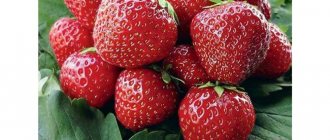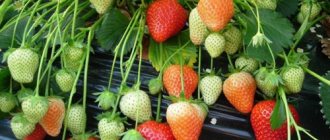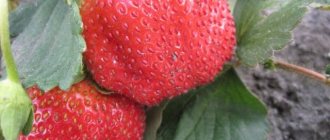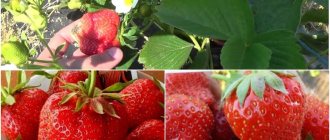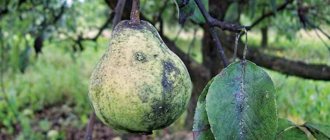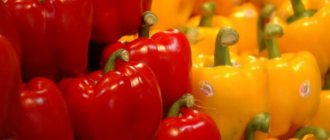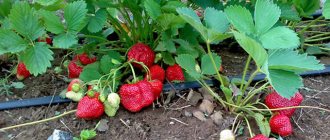The “Tsarina” variety of strawberries pleases with fragrant, large berries. Strawberries have gained popularity due to their unpretentiousness, enviable frost resistance and disease resistance. The low yield is fully compensated by the amazing taste and aroma of the fruit.
The creator of the variety, S.D. Aitzhanova, believes that the “queen” has inherited the best traits of its parents and is well suited for cultivation in the central regions of Russia. In 2009, strawberries were registered and included in the State Variety Commission.
Characteristics
Garden strawberries “queen” are classified as universal varieties. The characteristics of the crop make it possible to grow it in the conditions of a summer cottage and a small farm.
| Parameter | Characteristic |
| Ripening period | Average |
| How many times does it bear fruit per season? | Once, non-remontant variety |
| Yield per bush | Average: 0.6–0.8 kg per bush |
| Berry size | The first up to 50 g, the main collection up to 20 g |
| Form | Conical |
| Color | Bright red, with glitter |
| Taste qualities | Berries are sweet and juicy |
| Aroma | Light strawberry |
| Pulp | Scarlet, dense, no voids |
| Purpose of the variety | Universal |
| Drought resistance | High |
| Frost resistance, winter hardiness | From -15 to -30 ⁰С |
| Disease resistance | Weakly affected by white and brown spots, strawberry mite, gray rot. With poor care, you can get verticillium |
| Transportability of berries | 4.8 out of 5 points |
| Life cycle | 4 years |
| Tasting assessment | 4.8 out of 5 points |
Origin and zoning of the variety
“Tsarina” is considered one of the achievements of modern Russian selection. A team of specialists led by Professor S.D. Aitzhanova worked on its creation at the Kokinsky stronghold of VSTISP in the Bryansk region. The variety was obtained by crossing popular predecessors: the high-yielding Lithuanian “Venta” (combining the best qualities of “Zenga Zengana” and “Festivalnaya”) and the winter-hardy “Red Gauntlet”. Since 2002, “Tsarina” has undergone state variety testing and seven years later, in 2009, it was officially registered in the State Register of the Russian Federation by the originator of VSTISP as approved for cultivation in the Central region. Experts note that the variety is also well suited for the northwestern regions and the entire central zone of Russia, the Urals and Siberia, the territories of Ukraine and Belarus.
High productivity over three years of fruiting is confirmed by field test data - from 98.9 to 130 c/ha (from 350 g to 1 kg per bush).
Strawberry variety “Tsaritsa”
Victoria "Queen" exhibits different varietal characteristics depending on care and growing region.
Strawberries are valued for their ability to grow in short daylight conditions, in dry and rainy weather. With high snow cover, it easily withstands frosts down to -30 °C; in snowless winters it dies at -15 °C.
Characteristics of berries and bush
Strawberries are distinguished by low, compact bushes of medium foliage. The leaves are large, bright green, without pubescence. Fruit buds are laid during short daylight hours at the end of August or in the first ten days of September. The flowers are bisexual and do not require the presence of a pollinator. The variety is not reusable.
The berries have good taste and do not rot even in cold, rainy summers. The description of the “Tsarina” strawberry variety specifically indicates the excellent transportability of the fruit. They retain their shape when transported in hot weather and over long distances.
Productivity
Technical maturity of strawberries occurs in mid-June. The fruiting period of the “queen” is compressed, the last harvest is carried out in early July. From the bush, subject to agricultural technology, up to 700 g of berries are harvested.
In reviews, gardeners indicate that with a lack of moisture, the fruits become smaller, their weight does not exceed 9 g. In rainy weather, the weight of the berries increases to 40–50 g.
Advantages and disadvantages
Like any variety, queen strawberries have their pros and cons.
Advantages:
- drought resistance;
- fruits can withstand long-term transportation and storage;
- high immunity to diseases and pests;
- ease of care;
- suitable for commercial use;
- versatility and flexibility of the variety.
Flaws:
- with low snow cover in frosty winters, strawberries may die;
- fruiting declines sharply with age;
- To obtain a decent harvest, it requires good watering.
What regions is it suitable for?
The registrar in the description of strawberries of the “Tsarina” variety recommends for cultivation the Moscow region, Leningrad, Bryansk, Ryazan, Tula and other regions of the central and northwestern part of Russia.
If agricultural practices are followed, strawberries grow in Siberia and the Urals and bear fruit abundantly in Ukraine and Belarus.
Useful video about queen variety strawberries
History of growing strawberries Tsaritsa
The variety was bred in the climatic conditions of the Bryansk region, at the Kokinsky experimental site of VSTISP. Tsarina was obtained by crossing the Red Gauntlet and Venta varieties. These varieties of strawberries are native to Scotland and Lithuania. Their most important characteristics - enviable winter hardiness, even fruits and resistance to pests and diseases - were transferred to the Tsaritsa variety.
Shiny fruits of regular shape are a feature of the Tsaritsa variety
The author of the variety, Doctor of Science Svetlana Dmitrievna Aitzhanova, believes that this berry is distinguished by its qualities, and also has a rich aroma and good density necessary for transportation. The variety is included in the State Register of Breeding Achievements. Recommended for growing in garden plots in the temperate continental climate of the Central region of Russia.
The best place for queen strawberries
The ideal soil for the “Tsaritsa” variety is light, loamy, enriched with nutrients. Choose a flat, well-lit place. There should be no tall buildings or plantings nearby.
It will be possible to grow a “queen” on a balcony and windowsill only if there is good moisture and the bushes are located in a sunny place. In the northern regions, strawberries are planted in greenhouses.
Unwanted Precursors:
- Solanaceae;
- eggplant;
- raspberries.
According to gardeners, the “queen” grows well after garlic, herbs, onions, carrots and legumes.
Reviews
- Elena: “I chose strawberries according to the principle: “the simpler, the better.” The seller recommended “Tsaritsa”; I have never regretted the purchase. The variety is characterized by stable yields and simple agricultural technology. It is not always possible to visit the dacha often, so it is very important to choose a drought-resistant variety. The seedlings have taken root well and do not grow as densely as many other varieties. The yield is high, from a small plot it is about three to four buckets per season. For comparison, another high-yielding variety produces about six buckets, but in terms of taste, these fruits are noticeably inferior to the “royal” ones.” It is also worth reading reviews from summer residents about Kimberly strawberries.
- Andrey: “I’ve never been specifically involved in strawberries, but after the plantings became barren and the berries became small, I took this issue seriously. I purchased several varieties at once “for testing”; “Tsaritsa” was among the most advertised by the local seller. The variety turned out to be really worthy: despite the average size of the berries, there were 10–15 of them on each bush. I really liked the harvest in the first year, but the peak was in the second year. In my opinion, the variety is good, despite the fact that the berries are not very large. I really like the aroma of ripe fruits, which simply changes the taste of the preserved food. They are also very good fresh: they do not spread or sour when stored in the refrigerator, one of the most successful purchases.”
How to choose seedlings
The key to a good harvest is high-quality seedlings
When choosing “queen” strawberry seedlings, pay attention to the following characteristics:
- root length 10–12 cm;
- absence of signs of diseases and pests;
- at least 4 healthy, green leaves.
Strawberry seedlings with a closed root system, which are sold in a container, take root best.
How to propagate garden strawberries
Growing this crop on your own plot is not as difficult as it seems. It all depends on the method you choose, and there are three of them: using a mustache, dividing the bush and the seed method. And if the last option can still cause some trouble for the gardener, then the first two are not difficult at all.
Growing a mustache
Every gardener knows what a mustache is. And even if he doesn’t know, he definitely saw them. Thanks to these shoots, the bush has the ability to capture new territories and rejuvenate itself. You need to use tendrils from those plants that give the greatest yield and look better than others (they do not show signs of disease or the presence of pests). At the ends of some whiskers you can find forming rosettes with tiny roots. Just such a rosette can be pinned to the ground or to a plastic cup of soil so that it takes root. When it develops to a large size and forms a heart, the newly made bush can be transplanted to a permanent place, cutting it off from the food source.
Propagation by mustache is a reliable method that allows you to continue the population of healthy fruit-bearing strawberries
Dividing the bush
The method usually used for beardless varieties can also help you in the case of the Tsaritsa variety. As the starting material, you need to take the mother bush at the age of three or four years. Of course, it has proven itself well during fruiting. It should be divided into component parts, and each of them must have at least one developed leaf rosette and a heart. The roots are shortened to a length of 8 cm, after which the plant is planted in a new place and watered abundantly.
Planting seeds
The most time-consuming and also not the most reliable way to grow garden strawberries. But how nice it is to watch its growth from the very beginning, from a tiny seed. If you make up your mind and choose the seed method of propagating the Queen, follow the following procedure:
- In early March, take a container and fill it with soil, but not to the brim.
- Moisten the soil and plant the seeds in shallow furrows to a depth of no more than 0.5 cm, lightly sprinkling them on top.
- Fill the remaining space with snow and cover the container with a lid - now you can put it in the refrigerator for a couple of weeks.
- After the expiration date, remove the container from the refrigerator and place it on the windowsill.
- After one and a half to two weeks, the first shoots will appear, which means it’s time to make holes in the lid to allow air access to the plants. Watering is carried out based on the degree of soil moisture; a spray bottle is usually used for this purpose.
- In the phase of two true leaves, the plants dive, pinching the tip of the main root.
- At the stage of six true leaves, the plants are ready to move into open ground.
Do not forget to prepare the seedlings for life in the open air, that is, harden them. First, leave the window open for 15 minutes, then gradually increase the time, and soon the plants will be completely ready for transplanting.
For those who want to trace the life path of plants from beginning to end, there is a method of seed propagation - labor-intensive, but very exciting
Video: propagation of garden strawberries
Landing
The “queen” strawberry variety is recommended to be planted in spring. In the fall, the bushes will not have time to get stronger before the onset of frost. In the south of the country you can start rooting in September-October. But the work should be completed a month before the cold weather.
A week before planting, it is recommended to fertilize the soil by adding two buckets of humus, 50 g of urea and 30 g of ash per 1 m2, and dig up the beds.
How to plant strawberries correctly:
- Make holes according to the scheme: 20 cm between bushes, 40 cm between rows. Fill with water and wait for moisture to be absorbed.
- Soak the seedlings a quarter in any growth stimulant. If the root system is long, then trim it to 10 cm.
- Place the plants in the holes, placing the central bud above the ground level. Sprinkle with soil.
- Water again.
Beds with young plants are mulched with straw, peat or rotted sawdust.
Description
External characteristics of the strawberry variety Tsarina:
- half-spreading bush up to 25 cm high;
- the leaf blade is smooth, pale green, with rounded “teeth” along the edges;
- the inflorescences are white, do not rise above the bush, and are located in the middle part of the rosette;
- the fruits are the same size, regular shape and gloss;
- When ripe, the color of the berry is red, when cut it is bright pink; when overripe, the strawberry becomes red-burgundy.
The taste of the berry is sweet and sour, the aroma is bright. The sugar content in one strawberry is about 10%, acid - no more than 1%.
Excellent transportability allows you to store and transport ripe fruits. Thanks to these qualities, Tsarina strawberries are in demand in trade and the food industry.
Nutrients:
| Sahara | 9 % |
| Vitamin C | 76 mg% |
| Acids | 0,9 % |
Features of care
Reviews of the “queen” strawberry prove that the variety is unpretentious in care and does not require special agricultural technology that goes beyond the standard.
The plant produces a moderate amount of tendrils. This allows you to obtain a sufficient number of daughter rosettes suitable for propagation and renewal of the plantation.
Watering
Drip irrigation is the best solution for strawberries
For queen strawberries, it is worth installing drip irrigation. It is necessary to moisten the soil around the bushes regularly, which is not always possible for owners who come to the site only on weekends.
During the period of flowering and fruit formation, the variety is watered abundantly 2 times a week. The rest of the time, the procedure is carried out every 10–14 days, depending on the weather.
Top dressing
Excessive amounts of nitrogen should not be used for fertilizing. It should be applied only at the initial stage of growth of the queen strawberry, before flowering. Otherwise, the plant will begin to “fatten”, which will reduce the volume of the harvest.
| When to feed strawberries | What and how |
| In spring, after the snow melts | 20 g of urea per bush |
| During flowering | 250 g of chicken manure per 5 liters of water. Apply 0.5 liters of solution under the plant |
| After harvest | 20 g of any complex fertilizer for a bush |
| in autumn | 30 g of potassium sulfate and 40 g of superphosphate per 1 m2 of plantation |
Weeding and loosening
The “queen” variety needs regular weeding. Abundantly growing weeds around strawberries reduce the yield and reduce the weight of the fruit. Loosen the soil after watering and rain.
Reproduction
When propagated by seeds, the “queen” strawberry does not retain the main maternal characteristics. The bushes tolerate temperature changes, frosts and drought less well, and the berries become smaller and lose their taste.
The optimal way to obtain seedlings is by rooting tendrils or dividing adult bushes.
Transfer
The “queen” strawberries are rejuvenated every 4 years. The procedure is carried out in the spring. For rooting, use purchased or your own seedlings. Read more about how to replant strawberries in spring→
Trimming
After fruiting ends, cut off the entire green part of the strawberry, leaving 2-3 young leaves. In autumn, diseased parts of the plant are removed.
To prevent a decrease in yield, the mustache is removed regularly.
How to prune strawberries in the fall→
Mulching
Black agrofibre has become popular among gardeners.
Mulch protects strawberries from drying out the soil, weeds and overheating of the root systems. The following materials are used as covering material for the “Tsaritsa” variety: sawdust, straw, hay, pine needles, and tree bark.
Preparing for winter
In regions with little snow, in Siberia and the Urals, queen strawberries require careful preparation for winter. Plants are mulched with a layer of 10–15 cm and covered with agrofibre. In early spring, the material is removed and the remaining mulch is removed.
Rules for preparing for wintering:
- Clear the beds of weeds.
- Trim the tendrils and dried leaves.
- Carry out pre-winter watering.
- Mulch and cover with non-woven material.
In areas with winter temperatures down to -15 °C, plants do not need to be covered.
Growing rules
To successfully grow a variety, it is important to follow the planting and care rules developed by breeders. First, you should carefully select a site for your strawberry bed. For her they reserve:
- flat, well-windowed and sunny area;
- the most open place (for this, tall plants are not planted approximately 10 meters from the strawberries, buildings and barriers are not placed).
In some cases, a site with a slight slope is acceptable, but it is important to ensure that water does not stagnate at the roots. If you plant a berry in a low, swampy place, it will definitely get sick and produce a weak, small harvest.
The soil
Light loamy soil with nutrients is best suited:
- on clay and heavy soils, the plant will need to be drained - it is important to add coarse sand before digging;
- on sandy soils you will need at least a bucket of rotted cow manure, a glass of wood ash and 60 g of urea per 1 square meter. meter of area.
These components can be added to the soil during the autumn digging of the beds. If necessary, a deoxidizing agent is also added to the soil.
According to gardeners, the best soil for growing strawberries is light loamy soil with nutrients.
Landing
In the spring, coverings and dead parts of plants are cleared from old strawberry plantings, then the soil around the bushes is loosened and fertilizing is applied.
Seedlings prepared for new plantings are planted in April or September. But April plantings are more reliable, since the seedlings take root faster and immediately begin to noticeably grow.
Spring planting of strawberries is more reliable due to better survival rate
Plants are planted in loose soil well seasoned with humus and nitrogen-mineral fertilizers. Sequencing:
- Make separate holes or grooves to the depth of the roots of the seedlings.
- Be sure to spread the roots of the seedlings in different directions.
- Sprinkle the bush with soil (a necessary condition is that the central bud cannot be covered, it is located just above ground level).
- Water the bush immediately and carefully (it is better to do this in small portions, distributing the water around the plant).
- Carry out mulching (to do this, use dry grass, straw or sawdust in a layer of up to 5 cm).
To protect plantings from bird invasion, you can cover them with agrofibre (spunbond), but more reliably - with mesh. Then, during the rains, the berries and bushes will not remain under cover for a long time and will not rot.
Video: planting tips
How to choose seedlings
Why are experienced breeders convinced that only the correct choice of planting material will help achieve the expected results from cultivation? Because many diseases and pests are brought to our garden plots with purchased seedlings.
The author of the garden strawberry variety Tsarina Svetlana Aitzhanova recommends taking seedlings only:
- in breeding research centers with constant monitoring of seedlings;
- in nurseries where professional biotechnologists work on reproduction (in sterile conditions, using modern methods).
Only in these cases can one vouch for their purity. Such selection centers and stations operate in Moscow (at the Russian State Agrarian University named after K.A. Timiryazev), Orel, Tula, Michurinsk, Tambov region and others.
Strawberry seedlings are necessarily sold in separate containers, with a tightly protected root system. These conditions, when planted in a permanent place, give a survival rate of 100%.
An important clarification: when purchasing seedlings in a pot, you should inspect the roots - they should be evenly distributed throughout the container. If seedlings are sold in peat containers, strong and healthy roots are usually visible as they come out through the walls.
Planting material is of great importance for the health of strawberry bushes
Proper watering
Despite its known resistance to extreme heat, the Tsaritsa variety requires abundant watering for increased yield. In especially dry southern and southeastern regions of Russia, it is recommended to install a drip irrigation system.
Strawberries of the Tsaritsa variety require abundant, precisely controlled watering.
In the southern and central regions, if hot weather sets in for more than half a month, strawberries will require regular, abundant watering (20 liters of water for one large bush, no more than once a week). This amount of water will completely saturate the soil and wet it up to 30 cm deep. This is exactly how much space a well-grown root system takes up. This is especially important:
- during the period of abundant flowering of strawberries;
- during the formation of ovaries and fruits;
- at the time of filling and ripening of berries.
At other times, even in a steppe, arid climate, it will be enough to limit yourself to infrequent drip irrigation (2 times a month). Special systems for drip irrigation make it possible to reduce water consumption to one bucket of water per bush.
It is not recommended to water strawberries using sprinkling - water that gets on the bushes can cause rotting and molding of the fruits. Sprinkler irrigation is used on strawberry plantations only in very hot or windy weather, in which case the water dries out quickly without causing harm.
Recent Entries
Lilac perennials that are beautiful, compact and do not crowd out other plants Why when buying seedlings you should not take the sellers’ word for it and how to determine the age of the plant using 3 signs Tomato seedlings have turned purple or whitish: why the color has changed and how to save the plants
Garden bed care
For healthy development, young plants need weeding and loosening of the soil - strawberries need constant access of air to the roots. To do this, you need to avoid the appearance of a hard earthen crust. Main rules of care:
- loosening is carried out with a shovel along the edge of the row and a small hoe around the bush itself (do this carefully, without going deeper than 1 centimeter near the plant);
- At the same time, strawberry plantations are usually cleared of debris, old dry leaves and weeds.
With the onset of autumn, when the earth around the bushes noticeably settles and the plant grows roots vigorously, it is useful to hill up the strawberries. If this is not done, the roots will subsequently be exposed, the plant will weaken and may die from freezing.
Feeding
The period of flowering and fruit set is the best time to spray with potassium-dominant fertilizer
During the growth and development of garden strawberries, you must not forget about fertilizing:
- during planting of seedlings, a nitrogen-mineral complex consisting of ash, nitrophoska and urea is introduced;
- during flowering and fruit set, spraying is carried out with complex fertilizers with a predominance of potassium (it is also important to include manganese, boron, iron and other microelements);
- after the end of fruiting, it is useful to apply ready-made complex Spring-Summer fertilizer in the form of granules.
If garden strawberries do not receive enough fertilizer, their berries will gradually begin to shrink, become less aromatic and tender. The leaves will fade, curl and change from green to a paler, yellow or reddish color.
It is important not to forget that too much fertilizer has a negative effect on the taste of the crop. In addition, overfed fruits may suffer from gray rot. In case of overfeeding with nitrogen fertilizers, the so-called fattening of the bush will occur to the detriment of the appearance of fruits.
Mustache trimming
To save energy and ensure full development of strawberry bushes, it is important to trim their tendrils in a timely manner. It is more correct to do this twice a year:
- In spring, shortly before the plants bloom.
- In autumn, after harvest.
For work, it is better to choose dry and windless weather. You cannot cut your mustache without a tool. They must be trimmed with sharp garden shears or pruning shears. This is done to avoid damage to the root system during plucking.
It is better to remove the antennae completely. But if further propagation is planned, you need to leave only the first rosettes from the bush.
Pests and protection against them
Before planting seedlings in the garden, it is useful to make sure there are no pests. If the Tsaritsa variety is resistant to the main pest, the strawberry mite, then other parasites can cause serious harm to strawberries. More dangerous than others for its young shoots are the larvae of the cockchafer and wireworm.
Wireworm is one of the most dangerous pests for young strawberry shoots.
Their appearance is especially often influenced by the proximity of the site to the forest border.
Dangerous enemies of the strawberry bed - large larvae of the cockchafer
The most proven way to rid the soil of a personal plot of parasites is to add ammonia water. Planting alkaloid lupine also helps. The substances contained in this plant - alkaloids - inhibit the development of pests, and nodule bacteria living on the roots enrich the soil with the nitrogen necessary for strawberries.
During the period when flower stalks appear, to prevent the occurrence of harmful insects and powdery mildew, spray the plantings with a solution consisting of:
- Karbofos (60 g per bucket of water);
- colloidal sulfur (50 g per bucket of solution).
If by the end of summer small white-brown spots form on the leaves, you need to treat them with a weak solution of manganese. If this does not help, you need to follow the instructions:
- Remove old, diseased leaves.
- Treat them with Topaz fungicide.
- Pour iodine solution under the root (5 drops of iodine per 10 liters of water).
- After fruiting, also treat with Topaz.
- After harvesting, feed the plants with superphosphate.
Preparing strawberries for winter
A popular technique among gardeners is to completely mow or trim the bushes for the winter. But many people believe that it is enough to remove dried and diseased leaves. After all, the part located above the ground must have time to grow before late autumn, otherwise fruit buds will not appear.
“Unfortunately, to prevent the massive spread of mites and nematodes, you really have to mow down the leaves. But in order not to reduce winter hardiness, you need to cut off the leaves not before winter, as many amateur gardeners do, but immediately after picking the berries. Only then will winter hardiness (and, as a consequence, yield) not only not decrease, but even increase.
However, under no circumstances should the mown leaves (most likely infected) be left in the same bed or nearby, otherwise the work done will be useless, since the pests will return to the bushes. Diseased leaves should be buried as deep as possible in the compost heap, or even better, burned.
S.D. Aitjanova
It is better to cut off the leaves immediately after harvesting - this way the plants will be able to recover before winter.
Despite good winter hardiness, strawberries need a thick layer of snow or other cover. However, it all depends on the place of growth. In the central regions, the middle Volga region, and the Moscow region, the Tsaritsa variety does not need shelter and tolerates winter well. In steppe regions with little snow, as well as further north, it is wiser to cover the plantings for the winter with any vegetable mulch or agricultural fabric.
Without thick snow cover, the plant root system will only survive down to -14–16°C. If snow covers the ground with a layer of more than 25 cm, it will be able to protect strawberries even in frosts down to -35°C.
In a snowless, icy winter, be sure to cover the bed with spruce branches, straw, large leaves (maple, chestnut) or special covering materials. In steppe areas with strong winds, such a shelter should be securely fixed.
In a snowless winter, strawberries need shelter
Pests and diseases of strawberries
White spot
Powdery mildew
Root damaged by cockchafer larva
Wireworm
Queen strawberries are resistant to diseases and insects. In unfavorable years and if the rules of agricultural technology are violated, it can be affected by powdery mildew and white spotting. Among the pests, the variety is favored by strawberry mites, May beetle larvae and wireworms.
How to process strawberries:
- Ammonia solution - 40 ml of ammonia per bucket of water. Protects against diseases and pests.
- Karbofos - 75 g of product per 10 liters of water. Used against pests a month before harvest.
- Aktara - 1 g per bucket of liquid.
Actellik (1 ml/1 l of water) or Fufanon (5 ml/5 l of water) help to cope with mites on strawberries.
Advantages and disadvantages
The main advantages of the Tsaritsa strawberry variety include:
- quite high yield;
- stability of fruiting;
- pleasant dessert taste of ripe fruits and strawberry aroma;
- large-fruitedness of the first collected fruits;
- high resistance of the variety to frost and heat;
- versatility of the harvested crop;
- high resistance of the berry crop to a number of diseases characteristic of other strawberry varieties;
- the collected fruits tolerate transportation well over different distances.
The Tsaritsa strawberry has no major disadvantages, but it should be noted that this variety has poor resistance to verticillium.
Possible problems
One of the problems with queen strawberries is insufficient watering. If the harvest has decreased, the berries have become smaller, you need to increase the amount of water. But you shouldn’t over-water the plants either. In cold summers, fruit rot may appear.
Gardeners often complain about the small number of flower stalks on a bush. The reason may be poor overwintering or insufficient care of strawberries last fall. We must not forget about moisture-recharging irrigation, autumn feeding of the plantation and shelter for the winter in areas where there is little snow.
The queen strawberry variety is an excellent choice for summer cottages. The variety is adapted to unfavorable conditions, withstands heat and waterlogging, and is rarely affected by diseases. The berries grow aromatic and sweet and easily tolerate long-term storage.
How to collect and preserve the harvest?
The Tsaritsa variety is quite large-fruited. The berries are “calibrated”, that is, the same in size, which distinguishes this hybrid from others. Strawberries are mid-season, fruiting begins at the end of June and lasts about three weeks.
Berries that are not intended for long-term storage are picked ripe, avoiding overripeness. If you plan to transport the fruits over a long distance, then you need to collect them unripe. Place the berries in wooden or plastic boxes or baskets. Pick the strawberries along with the sepals.
Pick the strawberries together with the sepals, so the berry does not become deformed during transportation.
You can extend the shelf life of fresh strawberries by refrigerating them. To do this, immediately after picking, place the berries in the refrigerator and cool to a temperature of 0...+2°C, in such conditions it can be stored for up to three days, but the quality of the fruit will deteriorate significantly, they will lose their aroma. Therefore, it is recommended to eat the berries immediately, and freeze them for long-term storage, prepare jam, marmalade or other homemade preparations.
Reproduction
Strawberries of the Tsaritsa variety are easy to propagate with mustaches. As already described, a special mother plantation is left for this purpose. Such plants are fed and watered more intensively. After the rosettes are fully formed, they are cut off using pruning shears.
For planting mustaches, prepare seedling beds with loose, nutritious soil (a good option is peat + humus in a ratio of 50:50, 5-7 cm thick). In the first week, young plants are watered daily; after the development of the root system, the intensity of watering is reduced. In the fall or next spring, the mustache can be planted in a permanent place.
Transfer
When replanting plants into the soil, you need to take care of its fertility and the absence of pests.
Light soil, sandy and slightly acidic, is preferred. In the garden bed we maintain a distance of slightly more than 15 cm.
Up to 5 shoots with rosettes may appear on the main bush.
When the shoot has taken root and the new bush has grown sufficiently, you can cut off the shoot and replant the strawberry, choosing the right place. They make holes, and after placing the plants there, water them up to 0.5 liters.
Reproduction
Strawberries of the Tsaritsa variety are easy to propagate with mustaches. As already described, a special mother plantation is left for this purpose. Such plants are fed and watered more intensively. After the rosettes are fully formed, they are cut off using pruning shears.
For planting mustaches, prepare seedling beds with loose, nutritious soil (a good option is peat + humus in a ratio of 50:50, 5-7 cm thick). In the first week, young plants are watered daily; after the development of the root system, the intensity of watering is reduced. In the fall or next spring, the mustache can be planted in a permanent place.
Fertilizer and feeding
To feed this variety, use a bucket of humus per square meter of soil surface.
You need to take the same amount of peat, mixing it with sawdust. Mineral fertilizers are also used.
With the onset of spring, you need to clear the planting of leaves and add a nitrogen-mineral complex. They are also fed with ash and urea. During flowering and ovary formation, it is recommended to add microelements: potassium, manganese, iron.



